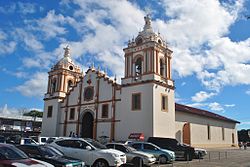Santiago, Panama
| Santiago de Veraguas | |
|---|---|
| City | |

Cathedral in Santiago de Veraguas
|
|
| Coordinates: 8°06′21″N 80°58′16″W / 8.10583°N 80.97111°W | |
| Country |
|
| Province | Veraguas |
| Founded | July 25th, 1621 |
| Area | |
| • Total | 975 km2 (376 sq mi) |
| Elevation | 101 m (331 ft) |
| Population (2010) | |
| • Total | 88,997 |
| • Density | 91/km2 (240/sq mi) |
| Time zone | ETZ (UTC-5) |
| Website | santiago |
Santiago de Veraguas (Spanish pronunciation: [sanˈtja.ɣo ðe βeˈɾa.ɣwas]) is the capital of the province of Veraguas, in the Republic of Panama, and the district or municipality of the same name. Located in the countryside on the banks of the Pan American Highway. Bounded on the north by San Francisco District, south with the District of Montijo, east District of Atalaya and west by the District of La Mesa.
Santiago was founded by the people of Montijo and Santa Fe in the 17th century, who gathered in this place, decided to found a city that served as the starting center dispatches. It was established south of the Martin Grande river commonly called Los Chorros.
Santiago did not exist in 1606 when the Bishop of Panama, Don Antonio Calderon, wrote his account of the peoples who formed the Province of Veragua. The Santa Fe (the oldest), San Pedro del Montijo, Atalaya, Nuestra Señora de Remedios and Alanje.
Nor does the poor mapping made by Lorenzo del Salto, dated 1620.
The 2930 manuscript of the National Library in Madrid clearly states that Santiago existed in 1621 (folio 159 r °) which corroborates the hypothesis that its foundation must have taken place or in the late 16th century or the early 17th century. Dr. Alberto Osorio Osorio: Colonial Santiago de Veraguas, Panama 1989, 83 p
The chronicler Juan Diez De La Calle in his "Collection of Documents of the Civil and Ecclesiastical History of America", states that the "city of Santiago de Veragua was founded on October 23, 1621."
The writer gave an account where they made known Indian cities and towns of the kingdom of Tierra Firme. Other evidence about the existence of the old city of Santiago, as it is called in contemporary documents providing information about his transfer in 1637, come from other valuable references and unpublished documents.
So there are two well-defined moments in the pages of the story of Santiago, the city of Santiago de Veragua the old October 23, 1621 and the new 1637. Mario Molina: Veraguas, Land of Columbus and Urraca, 2008
...
Wikipedia

